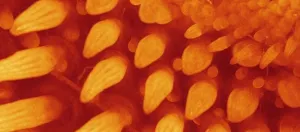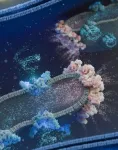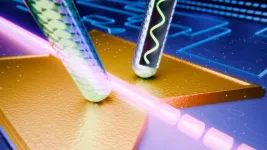(Press-News.org) Challenging assumptions about infant memory, a novel functional magnetic resonance imaging (fMRI) study shows that babies as young as 12 months old can encode memories, researchers report. The findings suggest that infantile amnesia – the inability to remember our first few years of life – is more likely caused by memory retrieval failures rather than an inability to form memories in the first place. Despite infancy being a period of rapid learning, memories from this time do not persist into later childhood or adulthood. In general, humans cannot recall events from the first three years of life – a phenomenon known as infantile amnesia. Why grown humans have a years-long blind spot in their episodic memory for the period of infancy remains a puzzle. One theory suggests this occurs because the hippocampus, a brain region crucial for episodic memory, is not fully developed during infancy. However, research in rodents challenges this idea, showing that memory traces, or engrams, are formed in the infant hippocampus but become inaccessible over time. In humans, infants demonstrate memory through behaviors such as conditioned responses, imitation, and recognition of familiar stimuli. However, whether these abilities rely on the hippocampus or other brain structures remains unclear. In a study using fMRI to scan the brains of infants aged ~4 to 25 months while performing a memory task, Tristan Yates and colleagues aimed to determine whether the hippocampus in infants can encode individual memories. The memory task, adapted from a well-established method for adults, involved showing images to infants – faces, scenes, and objects – followed by a memory test based on preferential looking, all while undergoing neuroimaging. The findings show that the infant hippocampus has the capacity to encode memories of individual experiences beginning around 1 year of age, providing evidence that the capacity to form individual memories develops during infancy. According to the authors, the presence of encoding mechanisms for episodic memory during infancy – despite their ephemeral nature – suggests that infantile amnesia is more likely due to failures in memory retrieval mechanisms. These insights align with recent studies in rodents, which demonstrate that memories created during infancy can persist into adulthood but remain inaccessible for retrieval without direct stimulation of hippocampal engrams or reminder cues, the authors note. In a Perspective, Adam Ramsaran and Paul Frankland discuss the study in greater detail.
END
Infants encode short-lived hippocampal memories
Summary author: Walter Beckwith
2025-03-20
ELSE PRESS RELEASES FROM THIS DATE:
Mountain uplift and dynamic topography shapes biodiversity over deep time
2025-03-20
Rising mountains do more than reshape the landscape – they also drive evolutionary change, according to a new study. By simulating millions of years of tectonic uplift, researchers have uncovered a link between mountain building and biodiversity, shedding light on how Earth’s dynamic topography shapes biodiversity over deep time. Mountain ranges are widely recognized as global hotspots of terrestrial biodiversity yet only cover a relatively small proportion of the Earth’s surface, suggesting a strong connection between topographic evolution and species diversity. Mountainous terrain can promote speciation by isolating populations, ...
Majority of carbon sequestered on land is locked in nonliving carbon reservoirs
2025-03-20
Challenging long-held assumptions about global terrestrial carbon storage, a new study finds that the majority of carbon dioxide (CO2) absorbed by ecosystems has been locked away in dead plant material, soils, and sediments, rather than living biomass, researchers report. These new insights, which suggest that terrestrial carbon stocks are more resilient and stable than previously appreciated, are crucial for shaping future climate mitigation strategies and optimizing carbon sequestration efforts. Recent studies have shown that terrestrial carbon stocks are increasing, offsetting ...
From dinosaurs to birds: the origins of feather formation
2025-03-20
Feathers are among the most complex cutaneous appendages in the animal kingdom. While their evolutionary origin has been widely debated, paleontological discoveries and developmental biology studies suggest that feathers evolved from simple structures known as proto-feathers. These primitive structures, composed of a single tubular filament, emerged around 200 million years ago in certain dinosaurs. Paleontologists continue to discuss the possibility of their even earlier presence in the common ancestor of dinosaurs and pterosaurs (the first flying vertebrates with membranous wings) around 240 million years ago.
Proto-feathers are ...
Why don’t we remember being a baby? New study provides clues
2025-03-20
Though we learn so much during our first years of life, we can’t, as adults, remember specific events from that time. Researchers have long believed we don’t hold onto these experiences because the part of the brain responsible for saving memories — the hippocampus — is still developing well into adolescence and just can’t encode memories in our earliest years. But new Yale research finds evidence that’s not the case.
In a study, Yale researchers showed infants ...
The cell’s powerhouses: Molecular machines enable efficient energy production
2025-03-20
Mitochondria are the powerhouses in our cells, producing the energy for all vital processes. Using cryo-electron tomography, researchers at the University of Basel, Switzerland, have now gained insight into the architecture of mitochondria at unprecedented resolution. They discovered that the proteins responsible for energy generation assemble into large “supercomplexes”, which play a crucial role in providing the cell’s energy.
Most living organisms on our planet-whether plants, animals, or ...
Most of the carbon sequestered on land is stored in soil and water
2025-03-20
Recent studies have shown that carbon stocks in terrestrial ecosystems are increasing, mitigating around 30% of the CO2 emissions linked to human activities. The overall value of carbon sinks on the earth's surface is fairly well known—as it can be deduced from the planet's total carbon balance anthropogenic emissions, the accumulation of carbon in the atmosphere and the ocean sinks—yet, researchers know very little about carbon distribution between the various terrestrial pools: living vegetation—mainly forests—and nonliving carbon pools—soil organic matter, sediments at the bottom of lakes and rivers, wetlands, ...
New US Academic Alliance for the IPCC opens critical nomination access
2025-03-20
WASHINGTON — The American Geophysical Union and the U.S. Academic Alliance for the IPCC today open calls for U.S. researchers to self-nominate as experts, authors and review editors for the Intergovernmental Panel on Climate Change Seventh Assessment Report through a new application portal. The IPCC nomination period opened in early March and will close in mid-April.
USAA-IPCC is a newly established network of U.S. academic institutions registered as observers with the IPCC. Both observer organizations and governments may nominate experts for ...
Breakthrough molecular movie reveals DNA’s unzipping mechanism with implications for viral and cancer treatments
2025-03-20
Scientists at the University of Leicester have captured the first detailed “molecular movie” showing DNA being unzipped at the atomic level – revealing how cells begin the crucial process of copying their genetic material.
The groundbreaking discovery, published in the prestigious journal Nature, could have far-reaching implications, helping us to understand how certain viruses and cancers replicate.
Using cutting edge cryo-electron microscopy, the team of scientists were able to visualise a helicase enzyme (nature’s DNA unzipping machine) in the process of unwinding DNA. DNA helicases are essential during DNA replication because ...
New function discovered for protein important in leukemia
2025-03-20
The protein (Exportin-1) is often found in high levels in patients with leukemia, other cancers
Protein was previously known to move materials out of a cell’s nucleus
New findings suggest protein may also stimulate transcription, which if hijacked, could contribute to abnormal cell division (cancer)
Future anti-cancer therapies that target Exportin-1’s role in transcription may be less toxic or more effective than current therapies
EVANSTON, Ill. --- Researchers from Northwestern University have stumbled upon a previously unobserved function of a protein found in the cell nuclei of all flora and fauna. In addition to exporting ...
Tiny component for record-breaking bandwidth
2025-03-20
Plasmonic modulators are tiny components that convert electrical signals into optical signals in order to transport them through optical fibres. A modulator of this kind had never managed to transmit data with a frequency of over a terahertz (over a trillion oscillations per second). Now, researchers from the group led by Jürg Leuthold, Professor of Photonics and Communications at ETH Zurich, have succeeded in doing just that. Previous modulators could only convert frequencies up to 100 or 200 gigahertz ...
LAST 30 PRESS RELEASES:
Making lighter work of calculating fluid and heat flow
Normalizing blood sugar can halve heart attack risk
Lowering blood sugar cuts heart attack risk in people with prediabetes
Study links genetic variants to risk of blinding eye disease in premature infants
Non-opioid ‘pain sponge’ therapy halts cartilage degeneration and relieves chronic pain
AI can pick up cultural values by mimicking how kids learn
China’s ecological redlines offer fast track to 30 x 30 global conservation goal
Invisible indoor threats: emerging household contaminants and their growing risks to human health
Adding antibody treatment to chemo boosts outcomes for children with rare cancer
Germline pathogenic variants among women without a history of breast cancer
Tanning beds triple melanoma risk, potentially causing broad DNA damage
Unique bond identified as key to viral infection speed
Indoor tanning makes youthful skin much older on a genetic level
Mouse model sheds new light on the causes and potential solutions to human GI problems linked to muscular dystrophy
The Journal of Nuclear Medicine ahead-of-print tip sheet: December 12, 2025
Smarter tools for peering into the microscopic world
Applications open for funding to conduct research in the Kinsey Institute archives
Global measure underestimates the severity of food insecurity
Child survivors of critical illness are missing out on timely follow up care
Risk-based vs annual breast cancer screening / the WISDOM randomized clinical trial
University of Toronto launches Electric Vehicle Innovation Ontario to accelerate advanced EV technologies and build Canada’s innovation advantage
Early relapse predicts poor outcomes in aggressive blood cancer
American College of Lifestyle Medicine applauds two CMS models aligned with lifestyle medicine practice and reimbursement
Clinical trial finds cannabis use not a barrier to quitting nicotine vaping
Supplemental nutrition assistance program policies and food insecurity
Switching immune cells to “night mode” could limit damage after a heart attack, study suggests
URI-based Global RIghts Project report spotlights continued troubling trends in worldwide inhumane treatment
Neutrophils are less aggressive at night, explaining why nighttime heart attacks cause less damage than daytime events
Menopausal hormone therapy may not pose breast cancer risk for women with BRCA mutations
Mobile health tool may improve quality of life for adolescent and young adult breast cancer survivors
[Press-News.org] Infants encode short-lived hippocampal memoriesSummary author: Walter Beckwith




